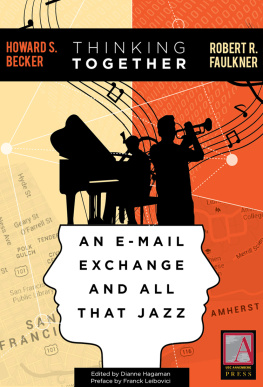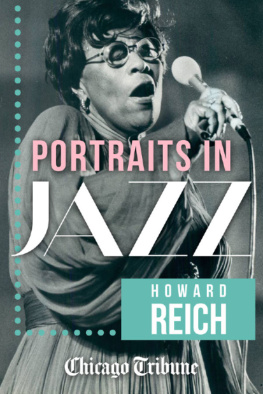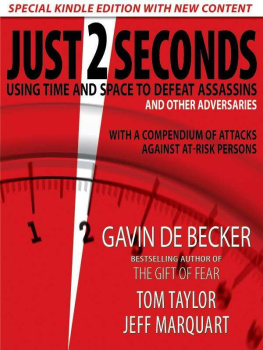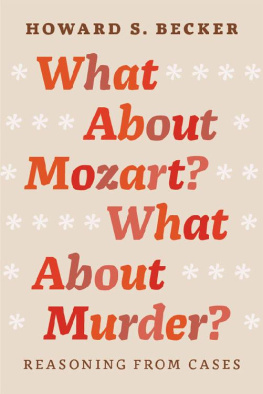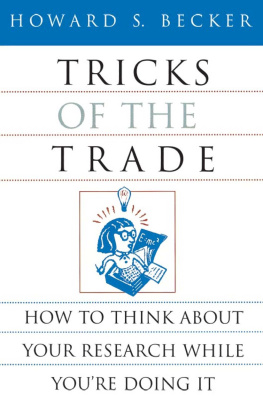Howard S. Becker - Thinking Together: An E-Mail Exchange and All That Jazz
Here you can read online Howard S. Becker - Thinking Together: An E-Mail Exchange and All That Jazz full text of the book (entire story) in english for free. Download pdf and epub, get meaning, cover and reviews about this ebook. year: 2013, publisher: USC Annenberg Press, genre: Art. Description of the work, (preface) as well as reviews are available. Best literature library LitArk.com created for fans of good reading and offers a wide selection of genres:
Romance novel
Science fiction
Adventure
Detective
Science
History
Home and family
Prose
Art
Politics
Computer
Non-fiction
Religion
Business
Children
Humor
Choose a favorite category and find really read worthwhile books. Enjoy immersion in the world of imagination, feel the emotions of the characters or learn something new for yourself, make an fascinating discovery.
- Book:Thinking Together: An E-Mail Exchange and All That Jazz
- Author:
- Publisher:USC Annenberg Press
- Genre:
- Year:2013
- Rating:5 / 5
- Favourites:Add to favourites
- Your mark:
- 100
- 1
- 2
- 3
- 4
- 5
Thinking Together: An E-Mail Exchange and All That Jazz: summary, description and annotation
We offer to read an annotation, description, summary or preface (depends on what the author of the book "Thinking Together: An E-Mail Exchange and All That Jazz" wrote himself). If you haven't found the necessary information about the book — write in the comments, we will try to find it.
Thinking Together: An E-Mail Exchange and All That Jazz — read online for free the complete book (whole text) full work
Below is the text of the book, divided by pages. System saving the place of the last page read, allows you to conveniently read the book "Thinking Together: An E-Mail Exchange and All That Jazz" online for free, without having to search again every time where you left off. Put a bookmark, and you can go to the page where you finished reading at any time.
Font size:
Interval:
Bookmark:

USC Annenberg Press is committed to excellence in communication scholarship, journalism, media research, and application. To advance this goal, we edit and publish prominent scholarly publications that are both innovative and influential, and that chart new courses in their respective fields of study. Annenberg Press includes e-books as a new cutting-edge forum featuring the work of both established and emerging scholars.
Larry Gross, Editor
Arlene Luck, Managing Editor
ISBN Ebook: 9781625172037

2013 USC Annenberg Press. Published under Creative Commons
Non-Commercial No Derivatives (by-nc-nd) license.
Table of Contents
an ecology of inquiryor a form of life
one fine day in may 2011, i received by e-mail a word document of 250 pages, titled thinking together. it was howard beckers and robert faulkners contribution to an inquiry begun a year earlier, titled (forms of life)an ecology of artistic practices . this inquiry, carried on not by a sociologist but by an artist and poet, began with a simply summarized hypothesis: a work of art is more than the artifact exhibited; for it to function in the widest possible way, its necessary to take into account the practices which have brought it into being, the forms of collective action which have carried it that far, the kinds of maintenance it needs, the marks of asceticism it displays, the public consequences it will generatethe ensemble that we will describe with the word ecosystem, in order to distinguish it as much as possible from the idea of context: while context always preexists the work, the ecosystem of the work is, in contrast, produced starting out from it. thus two works which may be formally and physically identical (two monochromatic paintings, for example, by a russian artist from the beginning of the 20th century and an american from the 60s) will not function in the same way because of their radically different ecosystems. that these art works were not only linked by, but are also carriers of forms of life, thats what we wanted to explore.
but this immediately poses several problems for us.
first, we didnt know how to represent the forms of life and their ecosystems. we didnt even know what should be understood by artistic practices. because, even though i am an actor in this world, i quickly realized that the practices of my comrades in contemporary art were so hybrid, so labile, distributed, collective, that a simple ethnographically intended visit to their studio wouldnt be enough to give me access to their practices. i would have to question them, assemble the pieces of the puzzle, try to reconstruct a much larger image. at the same time, i above all didnt want to content myself with their own commentaries on their work, because between what an artist does and what he says he does in fact, i wasnt interested in artists, what interested me were the art works. not the link between an artist and his practice, but the one between the art work and the practices it involves. not a sociology of professions which sometimes runs the risk of crushing the works by reducing them to side effects, to the status of a simple reflection of interactions taking place in a world, but an attempt to bring the works back to the center of our attention in order to evaluate their resultswithout, for all that isolating them, glorious, from the rest of the world, in an idealized autonomy. following these practices, these instruments, these collectives let me avoid traditional dangers and simplistic binary oppositions: the artist versus his work, production versus reception, individual versus society, etc. starting from practices, you are immediately at a level that is simultaneously intra- and trans-individual, taking you through all the strata until you find yourself at the heart of the institution in the blink of an eye and maybe back again. the institution was no longer this goliath crushing david, the artist, the institution was itself, like the practices, distributed, and could be found mixed into the very core of the practices and interactions.
in short, faced with these first two problems, we decided to let the artists themselves serve as our guides. after all, who knew better than them how to delimit the territory of their practices and point out their action.
so when, one fine spring day, i received the contribution of howard becker and robert faulkner, i came down to earth.
it wasnt as sociologists, taking a look, distant and learned, from outside, on this question that we had invited them to participate in our project, but as practitionerspractitioners of music, one plays the piano, the other the trumpetand practitioners of research. they sent me an electronic epistolary correspondence they had carried on for several years, dealing with the question of improvisation in jazz (how do people who dont know each other nevertheless play together for hours, in a bar, without having ever rehearsed?). but beyond the thematic contribution of their study, which developed a dynamic conception of the idea of repertoire, their text posed (in the framework of my inquiry) the question of the form of life of a research: what was the form of life of a research project? i had never asked myself that question before. that a research, just like a work of art, produced its own ecosystem, through an ensemble of practices, of collectives, of kinds of maintenance, forms of asceticism, public consequencesthats what their contribution let me see.
in the worlds i work and live incontemporary art and poetrypeople usually think, naively, that being scientific rhymes with following a strict research protocol, symbolized by an algorithm applied mechanically. this correspondence showed, in the expression scientific writing, the importance of the word writing, which we too often ignore, considering that doing science can exist perfectly well without writing science. we have today, however, a well-established history of the writing of science. this petty sin is found moreover, this time, among scientists themselves, who too often think of writing as a neutral and transparent medium which lets you put the results of your research on paper. in this view, writing serves simply to express data already gathered in proper form, independent of specific system of inscription. what this correspondence becker and faulkner sent me exemplified, on the contrary, was that the technologies of writing informed, in the course of the research, the very nature of the data.
the quality of a scientific study is often strongly linked to the quality of the data it has produced. but how are these data produced? by techniques of notation, by systems of representation. the pertinence of the descriptions produced cannot be dissociated from the resources, the instruments and techniques, of writing they were made with. by which i do not mean stylistic qualities (well written, badly written) nor the literary genre used (to describe, for instance, an idea in the form of a theatrical dialogue.) the resources of writing do not come into play only at the moment of editing, when the writing has been done, but also in the very production of the data; you get the data you get as a result of the technology of writing you have chosen. from this point of view, there is no such thing as raw data,, since the materials have already been mediated, already formatted, by the writing instruments, writers and setting chosen to produce them. in a certain sense, the resources of writing co-produce the raw material.
Font size:
Interval:
Bookmark:
Similar books «Thinking Together: An E-Mail Exchange and All That Jazz»
Look at similar books to Thinking Together: An E-Mail Exchange and All That Jazz. We have selected literature similar in name and meaning in the hope of providing readers with more options to find new, interesting, not yet read works.
Discussion, reviews of the book Thinking Together: An E-Mail Exchange and All That Jazz and just readers' own opinions. Leave your comments, write what you think about the work, its meaning or the main characters. Specify what exactly you liked and what you didn't like, and why you think so.

